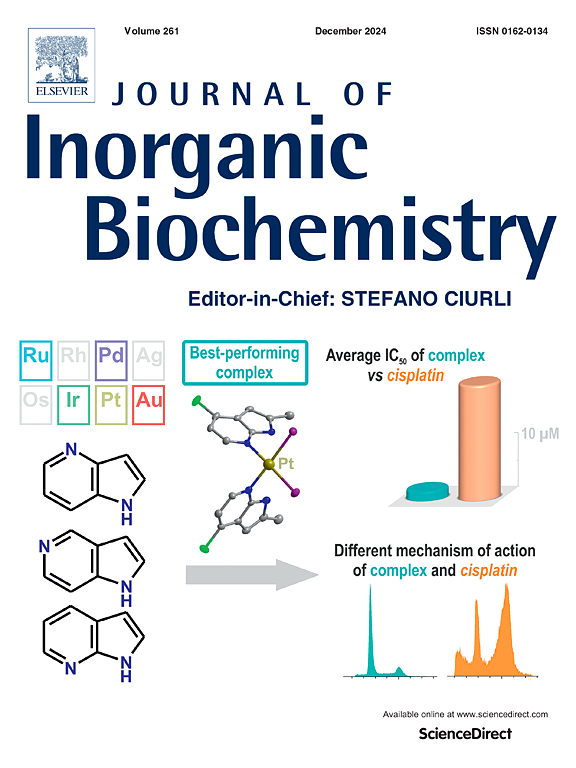带有光敏配体的高正电荷 Ru(II) 复合物可选择性地高效光灭活细胞内的金黄色葡萄球菌
IF 3.2
2区 化学
Q2 BIOCHEMISTRY & MOLECULAR BIOLOGY
引用次数: 0
摘要
由于宿主细胞提供的保护,细胞内金黄色葡萄球菌(S. aureus),特别是耐甲氧西林金黄色葡萄球菌(MRSA),与细胞外的对应物相比,具有更大的消灭难度。开发能够选择性和有效地根除细胞内细菌,包括耐药菌株,同时不易诱导细菌耐药的新型抗菌剂是非常需要的。本文设计并合成了两个具有光不稳定配体的Ru(II)配合物Ru1和Ru2。Ru1和Ru2都可以在光诱导的配体解离后与DNA共价结合。与Ru1相比,含有两个带正电的阳离子吡啶单元的三苯胺基团的掺入显著提高了Ru2的DNA结合常数,细菌结合/摄取水平,从而提高了Ru2的抗菌活性。Ru2可选择性光灭活细胞内金黄色葡萄球菌和MRSA,体外和体内均优于万古霉素。有趣的是,在亚致死浓度处理20天后,金黄色葡萄球菌细胞对辐照后的Ru2没有表现出明显的耐药性。这一令人振奋的结果可能为开发针对难治性细胞内病原体和普遍耐药的新型抗菌药物提供新的前景。本文章由计算机程序翻译,如有差异,请以英文原文为准。

A highly positively charged Ru(II) complex with photo-labile ligands for selective and efficient photo-inactivation of intracellular Staphylococcus aureus
Due to the protection afforded by host cells, intracellular Staphylococcus aureus (S. aureus), particularly methicillin-resistant S. aureus (MRSA), poses a significantly greater challenge to eliminate compared to the extracellular counterparts. It is highly desirable to develop novel antibacterial agents which are capable of selectively and efficiently eradicating intracellular bacteria, including drug-resistant strains, while being less prone to induce bacterial resistance. In this work, two Ru(II) complexes (Ru1 and Ru2) with photo-labile ligands were designed and synthesized. Both Ru1 and Ru2 could covalently bind to DNA after photo-induced ligand dissociation. Compared to Ru1, the incorporation of a triphenylamine group adorned with two positively charged cationic pyridine units significantly boosts the DNA binding constant, bacterial binding/uptake level, and subsequently, the antibacterial activity of Ru2. Ru2 could selectively photo-inactivate intracellular S. aureus and MRSA, being more efficient than vancomycin both in vitro and in vivo. Interestingly, after 20 days' treatment at sublethal concentrations, S. aureus cells exhibited no obvious drug resistance towards Ru2 upon irradiation. Such appealing results may provide new sights for developing novel antibacterial agents against intractable intracellular pathogens and also prevalent drug resistance.
求助全文
通过发布文献求助,成功后即可免费获取论文全文。
去求助
来源期刊

Journal of Inorganic Biochemistry
生物-生化与分子生物学
CiteScore
7.00
自引率
10.30%
发文量
336
审稿时长
41 days
期刊介绍:
The Journal of Inorganic Biochemistry is an established international forum for research in all aspects of Biological Inorganic Chemistry. Original papers of a high scientific level are published in the form of Articles (full length papers), Short Communications, Focused Reviews and Bioinorganic Methods. Topics include: the chemistry, structure and function of metalloenzymes; the interaction of inorganic ions and molecules with proteins and nucleic acids; the synthesis and properties of coordination complexes of biological interest including both structural and functional model systems; the function of metal- containing systems in the regulation of gene expression; the role of metals in medicine; the application of spectroscopic methods to determine the structure of metallobiomolecules; the preparation and characterization of metal-based biomaterials; and related systems. The emphasis of the Journal is on the structure and mechanism of action of metallobiomolecules.
 求助内容:
求助内容: 应助结果提醒方式:
应助结果提醒方式:


